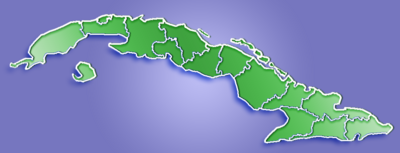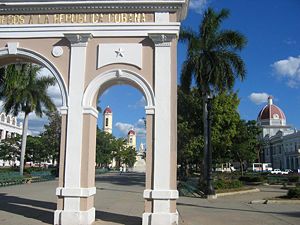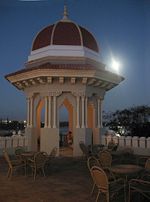Cienfuegos
| Cienfuegos | |
|
|
|
| Nickname(s): La Perla del Sur (Pearl of the South) | |
 |
|
| Coordinates: | |
| Country | |
|---|---|
| Province | Cienfuegos |
| Founded | 1819[1] |
| Area [2] | |
| - Total | 333 km² (128.6 sq mi) |
| Elevation | 25 m (82 ft) |
| Population (2004)[3] | |
| - Total | 163,824 |
| - Density | 492.0/km² (1,274.3/sq mi) |
| Time zone | EST (UTC-5) |
| Area code(s) | +53-432 |
Cienfuegos is a city on the southern coast of Cuba, capital of the province of Cienfuegos. It is located about 250 km (155 miles) from Havana, and has a population of 150,000. The city is dubbed "La Perla del Sur"(Pearl of the South). Cienfuegos literally translates to "Hundred fires".
Contents |
Geography
Near the entrance to Bahia de Cienfuegos (bahia meaning "bay") is Castillo de Jagua (full name Castillo de Nuestra Señora de los Angeles de Jagua), a fortress erected in the 1745 for protection against Caribbean pirates.
Cienfuegos, one of the chief seaports of Cuba, is a center of the sugar trade, as well as coffee and tobacco. While sugarcane is the chief crop, local farmers grow coffee.
The downtown contains 6 buildings from 1819-50, 327 buildings from 1851-1900, and 1188 buildings from the 20th century. There is no other place in the Caribbean which contains such a remarkable cluster of Neoclassical structures.
Demographics
In 2004, the municipality of Cienfuegos had a population of 163,824.[3] With a total area of 333 km² (128.6 sq mi),[2] it has a population density of 492.0/km² (1,274.3/sq mi).
History
The area was called Cacicazgo de Jagua when the Spanish arrived here, and was settled by indigenous people.
The city was settled by French immigrants from Bordeaux and Louisiana, led by Don Louis D'Clouet, on April 22 1819.[1] Its original name was Fernardina de Jagua, in honor of Ferdinand VII of Spain. The settlement became a town (Spanish: Villa) in 1829, and a city in 1880. The city was subsequently named Cienfuegos, sharing the name with Cienfuegos, a Captain General in this time, in the island.
During the Cuban Revolution the city saw an uprising against Fulgencio Batista and was bombed, on september 5 1957.[4]
World Heritage Site
| Urban Historic Centre of Cienfuegos* | |
|---|---|
| UNESCO World Heritage Site | |
 |
|
| State Party | |
| Type | Cultural |
| Criteria | ii, iv |
| Reference | 1202 |
| Region** | Latin America and the Caribbean |
| Inscription history | |
| Inscription | 2005 (29th Session) |
| * Name as inscribed on World Heritage List. ** Region as classified by UNESCO. |
|
In 2005, UNESCO inscribed the Urban Historic Centre of Cienfuegos on the World Heritage List, citing Cienfuegos as the best extant example of the 19th-century early Spanish Enlightenment implementation in urban planning.[5]
Hurricane Dennis 2005
In 2005, Hurricane Dennis made its second landfall near Cienfuegos at about 1:00PM AST (17:00 UTC) with winds of 232km/h (144 MPH), and gusts reaching 285 km/h (177 MPH).
Attractions

- Castillo de Nuestra Señora de los Ángeles de Jagua - fortress
- Arco de Triunfo - the only Arco de Triunfo in Cuba
- Cathedral de la Purisma Conception - cathedral with stained glass work, built 1833-1869.
- Delfinario - dolphins and sea lions in a saltwater lagoon
- Jardín Botánico de Cienfuegos - 97 hectares of botanic garden
- Museo Provincial - furniture and porcelain museum
- Palacio de Valle - built 1913-1917 in neo-gothic style
- Palmira Yorubá Pantheon - museum of religious afro-catholic syncretism
- Parque José Martí - park in Plaza de Armas
- University of Cienfuegos "Carlos Rafael Rodríguez" (UCF) - the province's secondary education institution.
Famous residents
- Benny Moré, Cuban singer.
Gallery
See also
- Municipalities of Cuba
- List of cities in Cuba
- Cienfuegos' Scientific Electronic Medical Journal
References
- ↑ 1.0 1.1 Guije.com. "Cienfuegos". Retrieved on 2007-10-07. (Spanish)
- ↑ 2.0 2.1 Statoids (July 2003). "Municipios of Cuba". Retrieved on 2007-10-07.
- ↑ 3.0 3.1 Atenas.cu (2004). "2004 Population trends, by Province and Municipality". Retrieved on 2007-10-07. (Spanish)
- ↑ Castro speech commemorates Moncada assault
- ↑ Cienfuegos at World Heritage List
External links
|
|||||||||||||||||
|
|||||||